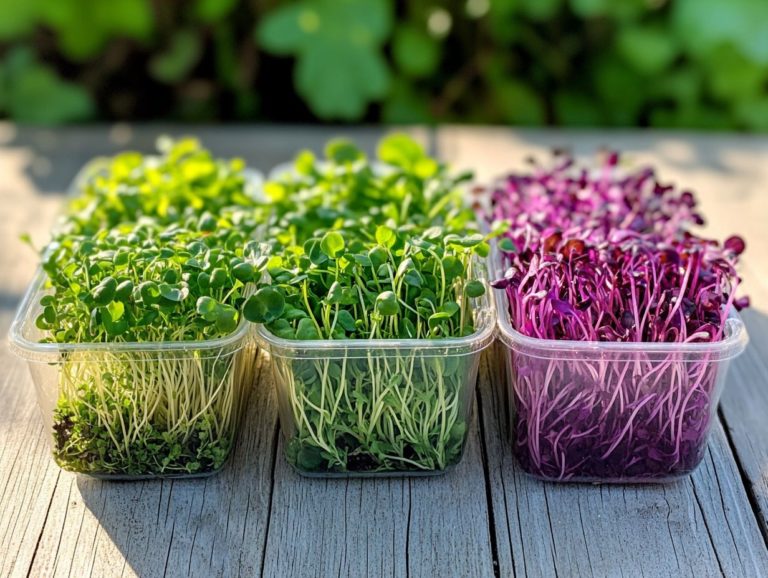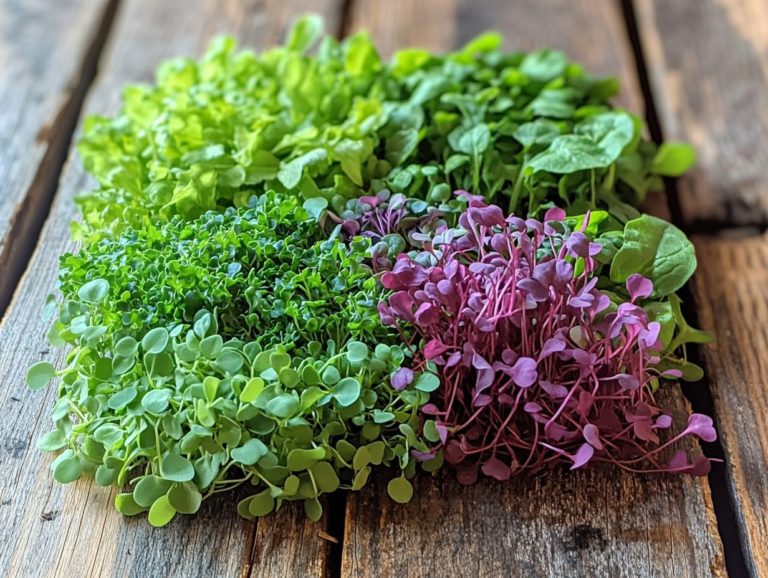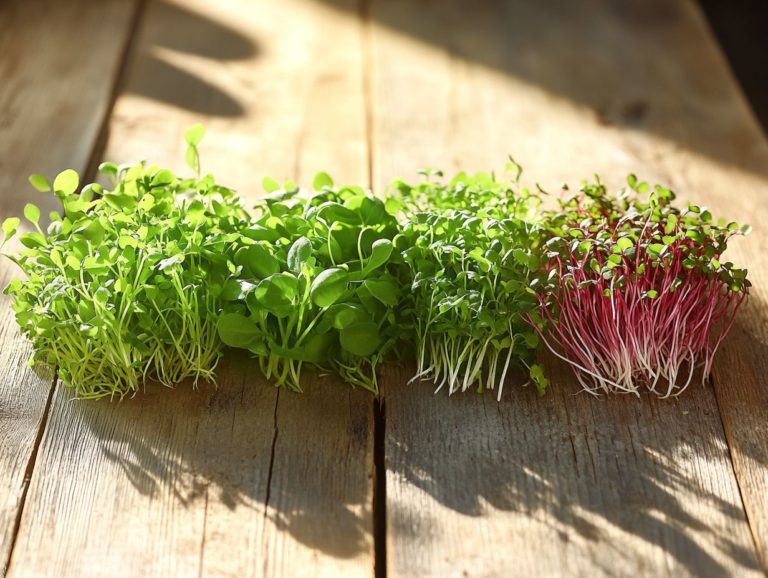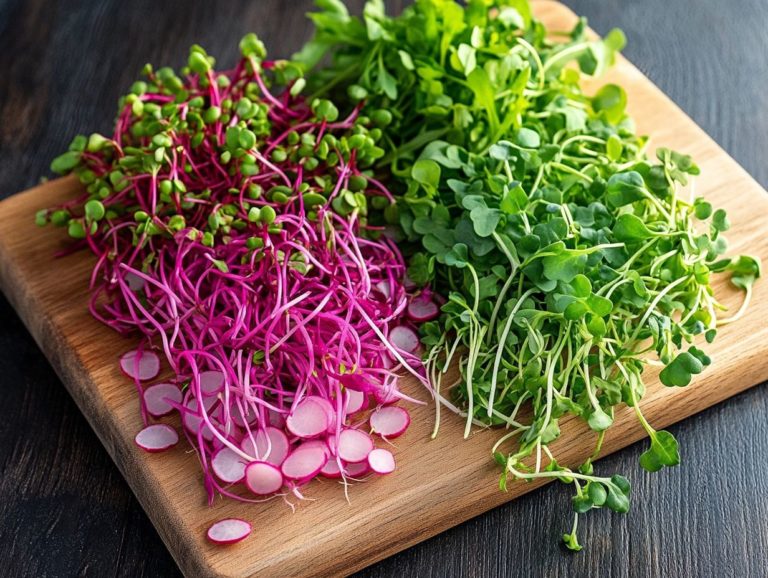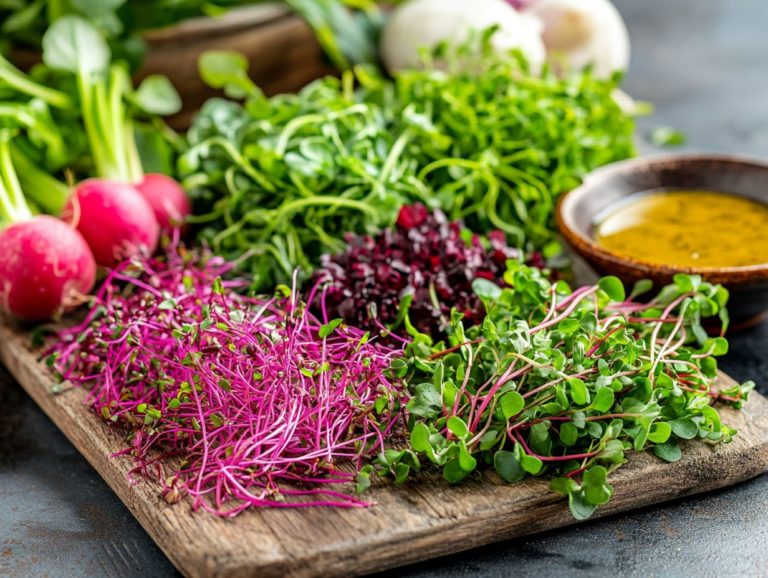Why Microgreens Are Superfoods You Need
Microgreens are delightful little plants that pack a punch in flavor and nutrition. They re not just a trendy garnish; they re a powerhouse of vitamins, minerals, and antioxidants!
Dive into the impressive nutritional benefits of microgreens and see how they stack up against other superfoods. You’ll discover innovative ways to weave them into your meals, enhancing both taste and health.
You can also learn how to grow your own microgreens and select the freshest options at the store. Let s dive in and find out why microgreens should be the star of your table!
Contents
Key Takeaways:
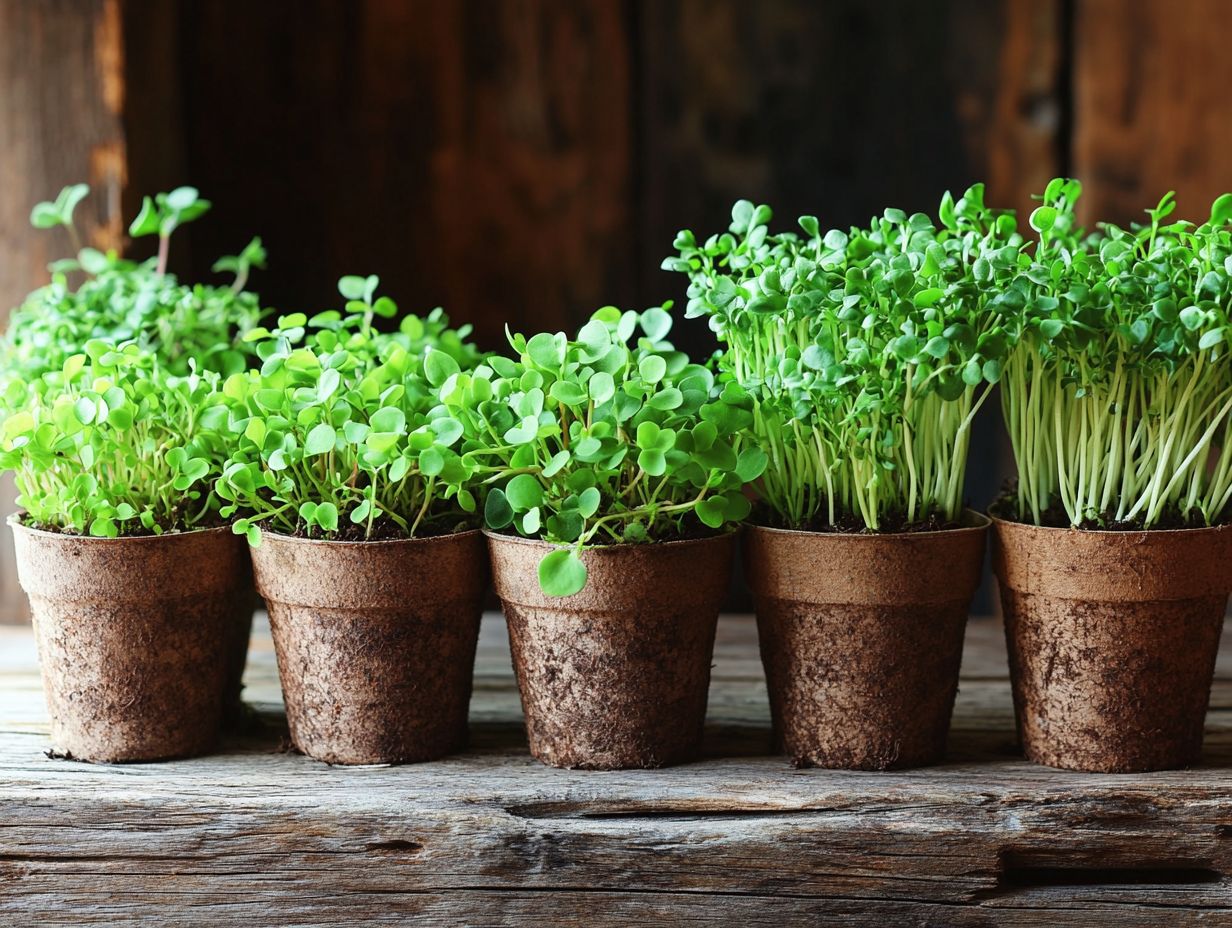
- Microgreens are nutrient-dense and packed with antioxidants, making them a powerful addition to any healthy diet.
- Incorporating microgreens into your meals is easy with a variety of recipes and meal ideas available.
- Growing your own microgreens at home is a cost-effective and rewarding way to enjoy these superfoods.
What are Microgreens?
Microgreens are young edible plants harvested just after their first true leaves emerge. Think of them as delightful mini versions of traditional vegetables and herbs. They are full of flavor and nutrients, making them very popular in the culinary world, enhancing everything from salads to garnishes.
Even historical figures like Benjamin Franklin recognized their potential, while modern advocates like Amanda Zaluckyj highlight their health benefits and versatility in urban farming.
These vibrant little wonders come in various species arugula, radish, basil, and kale offering an array of flavors and textures that can truly elevate any dish. Unlike their mature counterparts, microgreens boast a concentrated taste profile and a higher nutrient density, making them a go-to for chefs and health enthusiasts alike.
Their striking appearance adds visual appeal, perfect for plating gourmet creations or simply jazzing up your everyday meals.
With the growing trend toward sustainable eating, microgreens have garnered attention for their ease of cultivation. Whether you re a home gardener or a chef, you can effortlessly incorporate fresh, nutrient-rich greens into your diet.
Nutritional Benefits of Microgreens
Microgreens are not just a culinary indulgence; they are great for your health. Packed with an impressive array of vitamins, minerals, and antioxidants, they play a significant role in elevating your overall health.
Their remarkable nutrient density makes them an essential component of a balanced diet, especially if you’re looking to boost your gut health and strengthen your immune system. Embracing these tiny greens can truly transform your meals and your well-being.
High Levels of Nutrients and Antioxidants
Microgreens are celebrated for their impressive nutrient and antioxidant levels, offering concentrated health benefits that outshine their mature counterparts. They re an essential part of a nutrient-rich diet.
Research reveals that varieties like broccoli and radish microgreens pack a higher punch of vitamins and antioxidants, aiding in fighting chronic diseases and promoting overall wellness.
These tiny greens are particularly abundant in vitamins A, C, E, and K, along with essential minerals such as calcium and magnesium. Take broccoli microgreens, for example they re renowned for their remarkable levels of sulforaphane, a compound that helps detoxify the body and may reduce cancer risk, making them a powerful ally in chronic disease prevention.
On the other hand, radish microgreens provide dietary fiber, vital for digestive health, and potent antioxidants that help combat oxidative stress.
By weaving these vibrant varieties into your daily meals, you not only boost your nutrient intake but also harness the potential of these compounds to guard against issues like heart disease and diabetes.
Comparison to Other Superfoods
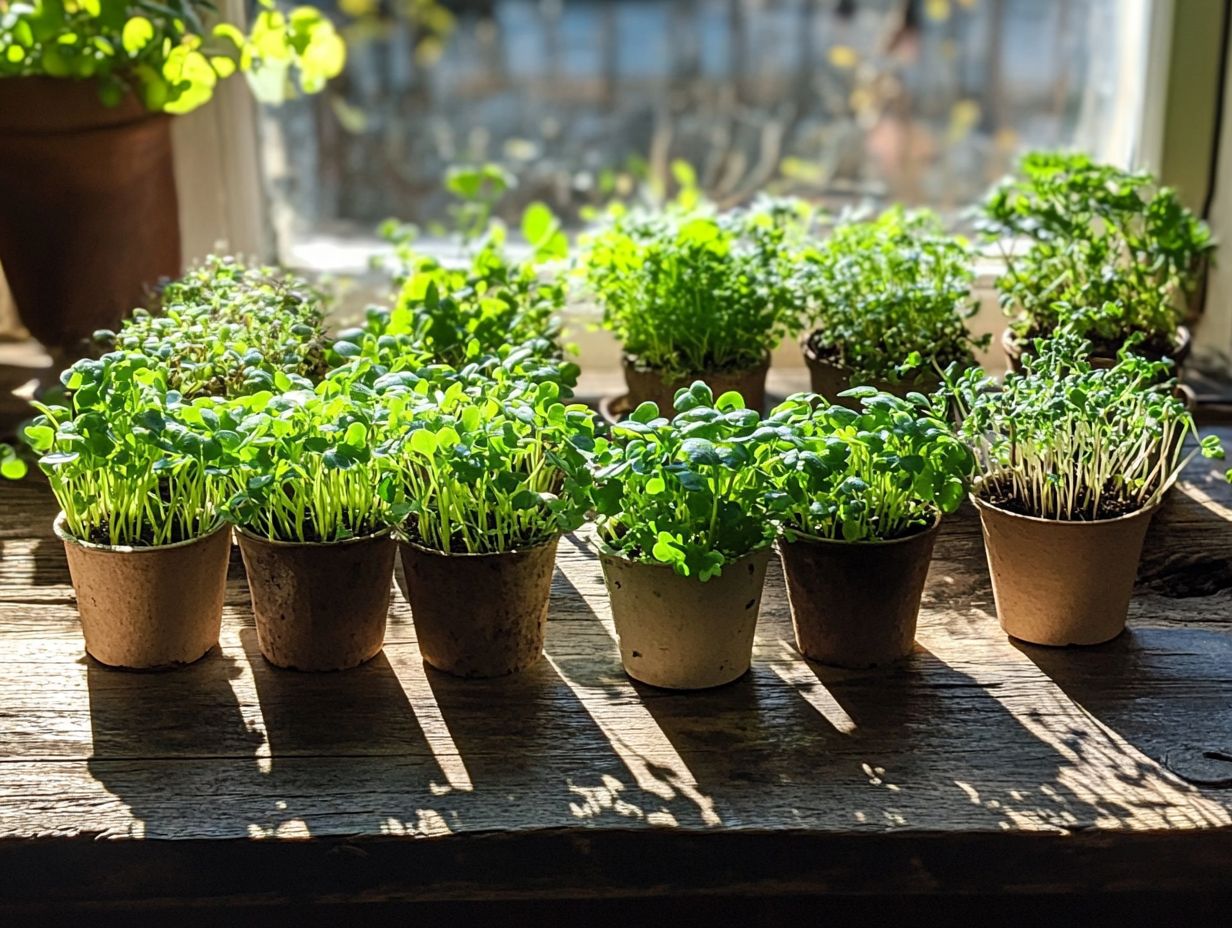
When you consider superfoods, microgreens truly shine with their exceptional nutrient profile and versatility, offering unique health benefits that often surpass those of traditional vegetables. Their rich plant compounds provide significant antioxidant potential, making them an ideal choice for anyone seeking foods that add health benefits to enhance their diet.
Unlike the widely celebrated superfoods like quinoa or kale, microgreens are harvested at an early stage of growth, allowing them to retain a concentrated amount of vitamins and minerals. Varieties such as broccoli, radish, and sunflower microgreens are particularly renowned for their high levels of vitamins A, C, E, and K, along with essential amino acids and omega-3 fatty acids.
Incorporating these vibrant greens into your meals boosts your nutritional intake and adds a delightful burst of flavor and color to your dishes. As more people discover their remarkable health benefits, microgreens are quickly becoming the go-to choice for those looking to elevate their culinary experiences while promoting overall wellness.
How to Incorporate Microgreens into Your Diet
Incorporating microgreens into your diet elevates both flavor and nutrition, presenting a delightful array of culinary applications to suit your diverse tastes and cooking styles.
Imagine vibrant salads bursting with freshness, gourmet sandwiches that are as visually appealing as they are satisfying, or even a touch of elegance as a garnish for soups. The possibilities are truly limitless, inviting you to unleash your creativity in meal planning while staying aligned with the ever-popular superfood movement.
Recipes and Meal Ideas
Countless recipes and meal ideas await you, ready to showcase the delicate flavors and textures of microgreens, ensuring each dish is not only visually appealing but also brimming with nutrients. Whether you’re crafting a refreshing salad with arugula microgreens or a hearty stir-fry featuring kale and cabbage varieties, integrating these superfoods into your meals is both effortless and gratifying.
Incorporating these nutrient-dense garnishes elevates not just the aesthetic appeal of your dishes but their overall taste as well. Picture a vibrant microgreen pesto, spreading its unique herbal notes onto whole grain toast, or a creamy soup finished with radish microgreens for that zesty kick.
With various microgreens offering distinct flavors like the sweet notes of pea shoots or the peppery bite of mustard greens the culinary possibilities are endless. By experimenting with these tiny greens, you allow for an exciting fusion of flavors and textures, transforming simple meals into exciting culinary delights that will impress your guests.
Growing Your Own Microgreens
Growing your own microgreens is a delightful endeavor that not only delivers fresh produce to your kitchen but also aligns seamlessly with sustainable farming practices. It s an ideal pursuit for urban farming enthusiasts like you.
Whether you re working with a cozy balcony or an expansive garden, cultivating these nutrient-packed greens promises to be both a fun and rewarding experience.
Start your journey with microgreens today and elevate your meals to a new level!
Benefits of Home Grown Microgreens
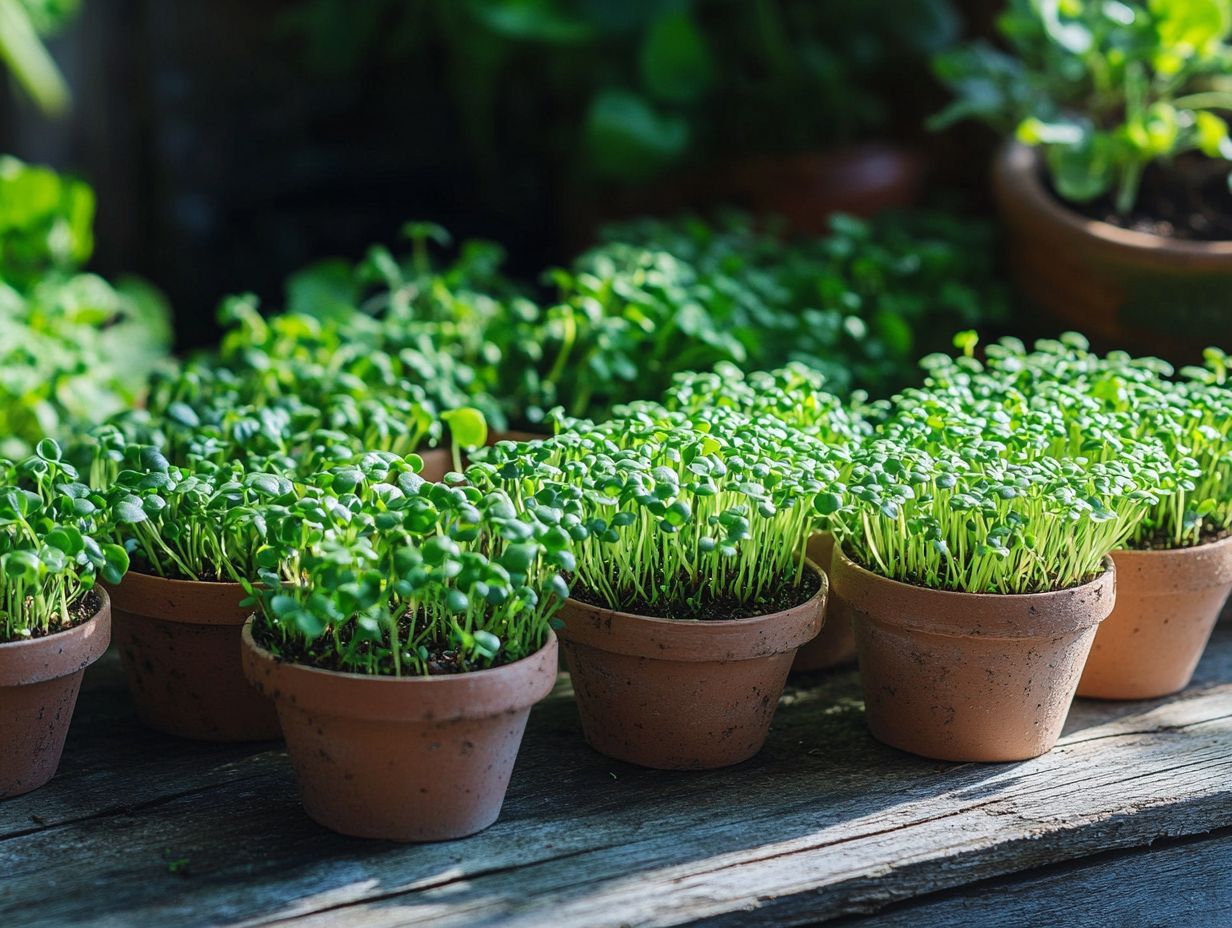
Homegrown microgreens offer a wealth of benefits that elevate your cooking experience. With them, you gain access to fresh produce and the power to control your growing conditions.
These tiny greens provide considerable health improvements thanks to their unmatched freshness and nutrient density. By cultivating microgreens at home, you embrace sustainable farming practices while enjoying a continuous supply of these flavorful superfoods.
Microgreens don t just add a pop of flavor to your dishes; they also deliver a remarkable nutritional boost, often containing higher concentrations of vitamins and minerals than their mature counterparts. You can easily customize aspects like light, water, and soil quality, ensuring that each crop retains its peak nutritional value!
This personalized growing experience fosters a deeper connection to your food, giving you the power to make healthier choices that enrich your daily meals.
Homegrown microgreens help reduce your reliance on store-bought produce, minimizing exposure to pesticides and maximizing your intake of wholesome, organic greens.
Step-by-Step Guide to Growing Microgreens
A step-by-step guide to growing microgreens transforms the process into a straightforward and enjoyable experience, giving even beginners the power to thrive in this accessible gardening venture.
By embracing simple sprouting techniques and grasping the essential requirements for light, water, and soil, you can harvest your own nutrient-dense microgreens in just a few weeks.
With just a handful of basic materials seeds, a growing medium like soil or hydroponic mats, and containers you can embark on this rewarding journey. Optimal conditions are vital. Ensuring adequate light, whether through natural sunlight or grow lights, sets the stage for success.
Consistent moisture levels are equally important to encourage robust growth. As your microgreens flourish, regular care tips, such as monitoring for pests and adjusting light exposure, can significantly boost your yield.
This simple process leads to delicious greens and an exciting gardening adventure for anyone eager to explore the joys of gardening.
Buying and Storing Microgreens
When you re buying and storing microgreens, knowing how to select the finest fresh produce is crucial for maximizing both flavor and nutritional benefits, particularly in a commercial production setting.
Recognizing the nuances of growing methods that avoid chemicals can significantly impact your choices, giving you the power to select the highest quality microgreens available.
Tips for Choosing and Storing Fresh Microgreens
Choosing and storing fresh microgreens with care can greatly enhance their health benefits and culinary applications. When selecting microgreens, look for vibrant colors and crisp leaves these are your indicators of freshness.
Proper storage methods are essential to retain their flavor and nutrients. Pay attention to the texture; microgreens should feel crisp and firm, avoiding any signs of wilting or mushiness. Ideally, they should be freshly harvested, as this boosts their nutritional profile.
To extend their shelf life, store them in a breatheable container, like a paper bag or a container lined with a damp paper towel. Keep them chilled in the refrigerator to prevent moisture buildup and preserve their vibrant taste.
This approach transforms each bite into a delightful enhancement for your dishes, whether you’re garnishing a salad or elevating a gourmet meal.
Watch this quick tutorial on how to grow your own microgreens!
Frequently Asked Questions
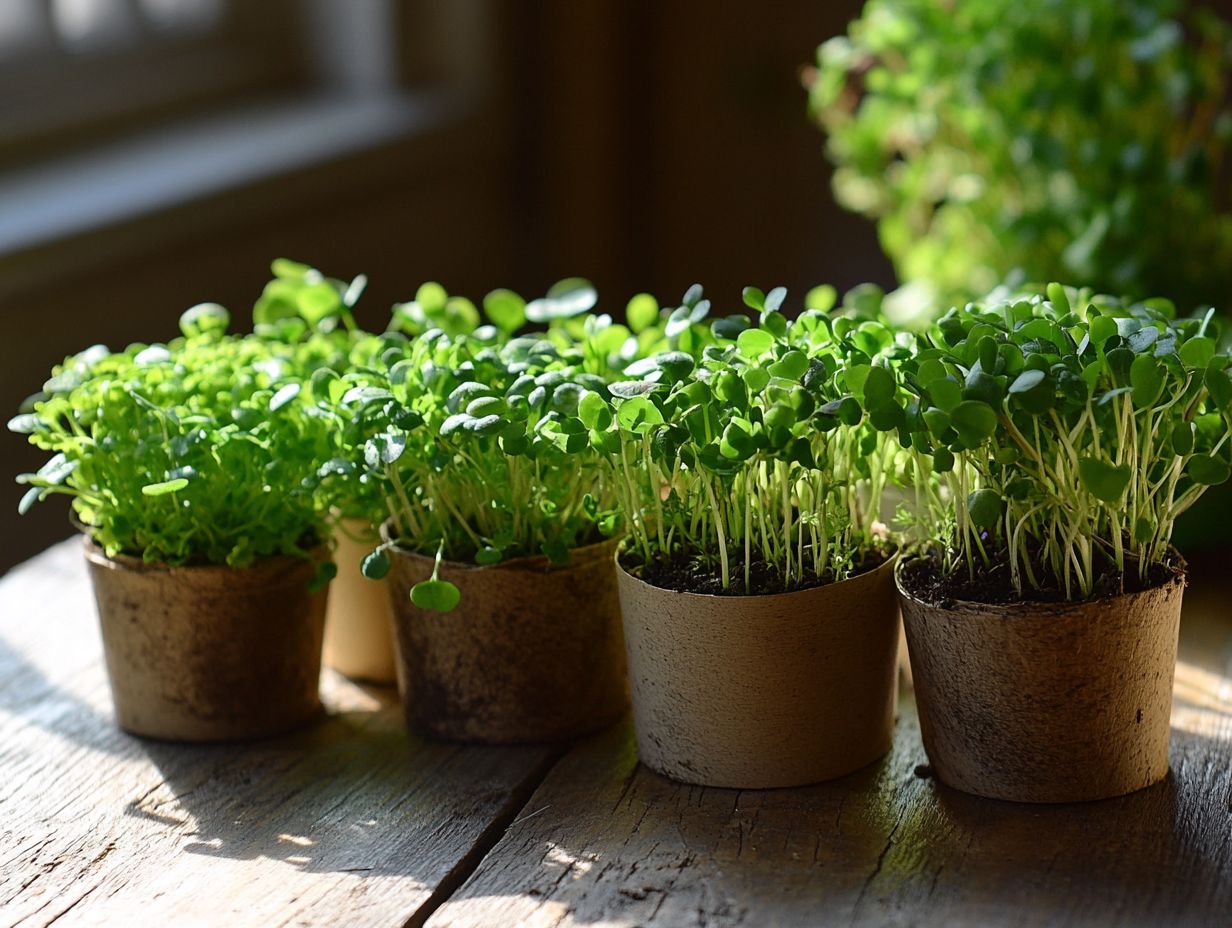
What are microgreens and why are they considered superfoods?
Microgreens are young vegetable greens that are harvested after the first sprout of leaves. They are considered superfoods because they are packed with nutrients and antioxidants that are beneficial for our health.
Now that you know the benefits and how to grow them, it’s time to dive into the world of microgreens!
Why do I need microgreens in my diet?
Microgreens are full of nutrients. They have more vitamins, minerals, and antioxidants than mature greens.
Including them in your diet can improve your overall health and help prevent chronic diseases.
How do microgreens help improve our health?
Microgreens are rich in vitamins A, C, and K, as well as folate, iron, and calcium.
These nutrients boost our immune system and support healthy bones and teeth.
Are microgreens more beneficial than regular greens?
Yes, microgreens are generally more nutritious than their mature counterparts.
They contain higher levels of antioxidants, like beta-carotene and lutein, which protect our cells from damage.
Can I grow my own microgreens at home?
Absolutely! You can grow your very own microgreens at home. All you need are seeds, soil, and water.
They require minimal space and can be harvested within a few weeks.
What are some ways to incorporate microgreens into my diet?
Microgreens can be added to salads, sandwiches, smoothies, and soups.
Use them as a garnish for various dishes or sprinkle them on pizza and pasta for a burst of flavor and nutrients.


